15 Nuts and Seeds High in Potassium
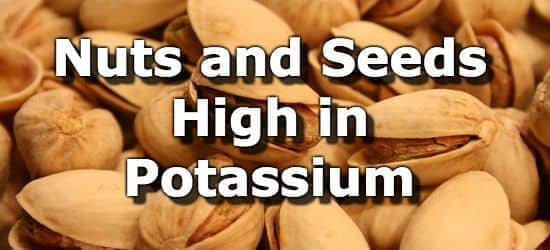
Potassium is an essential nutrient necessary for maintaining cell signaling and electrolyte balance in all living things. Since potassium is so universally needed it is often found concentrated in plant foods.
Nuts and seeds typically do not have as much potassium as fruits and vegetables but can still be a good source.
High potassium nuts and seeds include coconut water, hemp seeds, sunflower seeds, pistachios, squash seeds, flax seeds, hazelnuts, almonds, Brazil nuts, and watermelon seeds. The current daily value (DV) for potassium is 4700mg, recently increased from 3500mg by the FDA.
See the list below for details on the 15 nuts and seeds with the most potassium. For more information, see the list of high potassium foods.
High Potassium Nuts and Seeds
 1 Coconut Water
1 Coconut Water| Potassium per Cup | Potassium per 100g | Potassium per 200 Calories |
|---|---|---|
| 600mg (13% DV) | 250mg (5% DV) | 2632mg (56% DV) |
- 11% DV per cup of coconut milk
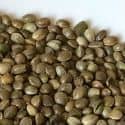 2 Hemp Seeds
2 Hemp Seeds| Potassium per Oz | Potassium per 100g | Potassium per 200 Calories |
|---|---|---|
| 341mg (7% DV) | 1200mg (26% DV) | 434mg (9% DV) |
 3 Pistachios (Dry Roasted)
3 Pistachios (Dry Roasted)| Potassium per 1 Oz Handful | Potassium per 100g | Potassium per 200 Calories |
|---|---|---|
| 286mg (6% DV) | 1007mg (21% DV) | 352mg (7% DV) |
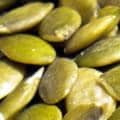 4 Squash and Pumpkin Seeds
4 Squash and Pumpkin Seeds| Potassium per 1 Oz Handful | Potassium per 100g | Potassium per 200 Calories |
|---|---|---|
| 261mg (6% DV) | 919mg (20% DV) | 412mg (9% DV) |
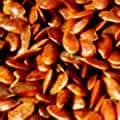 5 Flax Seeds
5 Flax Seeds| Potassium per Oz | Potassium per 100g | Potassium per 200 Calories |
|---|---|---|
| 231mg (5% DV) | 813mg (17% DV) | 304mg (6% DV) |
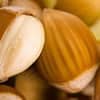 6 Hazelnuts (Filberts) (Dry Roasted)
6 Hazelnuts (Filberts) (Dry Roasted)| Potassium per 1 Oz Handful | Potassium per 100g | Potassium per 200 Calories |
|---|---|---|
| 214mg (5% DV) | 755mg (16% DV) | 234mg (5% DV) |
 7 Almonds
7 Almonds| Potassium per 1oz Handful | Potassium per 100g | Potassium per 200 Calories |
|---|---|---|
| 208mg (4% DV) | 733mg (16% DV) | 253mg (5% DV) |
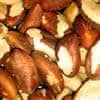 8 Brazil Nuts
8 Brazil Nuts| Potassium per 1 Oz Handful | Potassium per 100g | Potassium per 200 Calories |
|---|---|---|
| 187mg (4% DV) | 659mg (14% DV) | 200mg (4% DV) |
 9 Dried Watermelon Seeds
9 Dried Watermelon Seeds| Potassium per 1oz Handful | Potassium per 100g | Potassium per 200 Calories |
|---|---|---|
| 184mg (4% DV) | 648mg (14% DV) | 233mg (5% DV) |
 10 Sunflower Seeds
10 Sunflower Seeds| Potassium per 1 Oz Handful | Potassium per 100g | Potassium per 200 Calories |
|---|---|---|
| 181mg (4% DV) | 645mg (14% DV) | 221mg (5% DV) |
 11 Peanuts (Dry Roasted)
11 Peanuts (Dry Roasted)| Potassium per Oz | Potassium per 100g | Potassium per 200 Calories |
|---|---|---|
| 180mg (4% DV) | 634mg (13% DV) | 216mg (5% DV) |
Note: Peanuts are actually a legume but are listed here since they are nuts in the culinary sense.
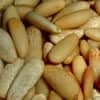 12 Pine Nuts
12 Pine Nuts| Potassium per 1 Oz Handful | Potassium per 100g | Potassium per 200 Calories |
|---|---|---|
| 178mg (4% DV) | 628mg (13% DV) | 200mg (4% DV) |
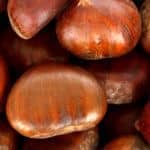 13 Chestnuts
13 Chestnuts| Potassium per oz(~3 Chestnuts) | Potassium per 100g | Potassium per 200 Calories |
|---|---|---|
| 168mg (4% DV) | 592mg (13% DV) | 483mg (10% DV) |
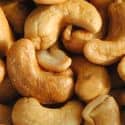 14 Cashews (Dry Roasted)
14 Cashews (Dry Roasted)| Potassium per 1 Oz Handful | Potassium per 100g | Potassium per 200 Calories |
|---|---|---|
| 160mg (3% DV) | 565mg (12% DV) | 197mg (4% DV) |
 15 Dried Coconut
15 Dried Coconut| Potassium per Oz | Potassium per 100g | Potassium per 200 Calories |
|---|---|---|
| 154mg (3% DV) | 543mg (12% DV) | 165mg (4% DV) |
How much potassium do you need each day?
The daily value (%DV) for Potassium is 4700mg and is a general target intended for most people. Adquate intakes (%AI) take age and gender into account and range from 2000mg - 3400mg for most people.
| Life Stage | AI | Infants |
|---|---|
| 0-6 months old | 400mg |
| 7-12 months old | 860mg |
| Children | |
| 1-3 years old | 2000mg |
| 4-8 years old | 2300mg |
| Males | |
| 9-13 years old | 2500mg |
| 14-18 years old | 3000mg |
| 19+ years old | 3400mg |
| Females | |
| 9-13 years old | 2300mg |
| 14-18 years old | 2300mg |
| 19+ years old | 2600mg |
| Pregnancy | |
| 14-18 years old | 2600mg |
| 19+ years old | 2900mg |
| Lactation | |
| 14-18 years old | 2500mg |
| 19-30 years old | 2800mg |
About the Data
Data for the curated food lists comes from the USDA Food Data Central Repository.
You can check our data against the USDA by clicking the (Source) link at the bottom of each food listing.
Note: When checking data please be sure the serving sizes are the same. In the rare case you find any difference, please contact us and we will fix it right away.
About Nutrient Targets
Setting targets can provide a guide to healthy eating.
Some of the most popular targets include:- Daily Value (%DV) - The daily value (%DV) is a general guideline for consumption that will prevent deficiency of a particular nutrient in most people. The %DV refers to the percentage of an amount that's found in a single serving of a food. It also accounts for absorption factors. It is set by the U.S. FDA.
- Recommended Dietary Allowance (%RDA) - The RDA sets an average daily dietary intake level that is sufficient to meet the nutrient requirements of nearly all (97.5%) healthy individuals. It's more specific than the daily value, and varies by age and gender. The RDA is set by the US National Institutes of Health.
- Reference Dietary Intake (%RDI) -The reference dietary intake is similar to the recommended daily allowance, but is specific to age and gender. The RDI for amino acids is set by the U.N. World Health Organization.
- Adequate Intake (%AI) - This value is primarily used in reference to omega-3 and omega-6 fats. The Adequate Intake is set by the U.S. Institute of Medicine. Because there is less evidence to determine the ideal targets for consumption of these nutrients, the specific amount is considered to be less reliable. Using the term Adequate Intake, rather than one of the other terms, helps to emphasize that the ideal intake of that particular nutrient has not yet been scientifically determined.
See the Guide to Recommended Daily Intakes for more information.
Want to set your own targets? Sign up for an account and set custom targets in the daily meal planner.From the Nutrient Ranking Tool
Use the ranking tool links below to select foods and create your own food list to share or print.
- Foods High in Potassium
- Foods Low in Potassium
- Vegetables High in Potassium
- Fruits High in Potassium
- Vegetarian Foods High in Potassium
- Nuts High in Potassium
- Grains High in Potassium
- Beans High in Potassium
- Dairy High in Potassium
- Breakfast Cereals High in Potassium
- Fast Foods High in Potassium
View more nutrients with the nutrient ranking tool, or see ratios with the nutrient ratio tool.
Related
Data Sources and References
Try the recipe nutrition calculator, or daily meal planner.
Create a free account to log and track foods.
